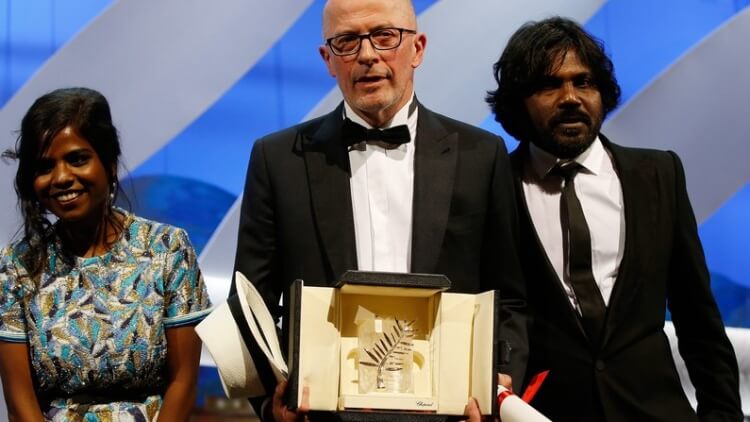Conceal me what I am, and be my aid
For such a disguise as haply shall become
The form of my intent […]
Lead me on.
—Twelfth Night (1.2. 50-61), Shakespeare
Plenty of people changed their names: actors, writers, revolutionaries, travesties. In history class, Gogol has learned that European immigrants had their names changed at Ellis Island, that slaves renamed themselves once they were emancipated […] They had all renamed themselves, the article said, adding that it was a right to belonging to every American citizen. He read that tens of thousands of Americans had their names changed each year.
—The Namesake, Jhumpa Lahiri
In 1917, equipped with a Williamson silent movie camera—a polished, wooden rectangle box with brass edges, crank on the right, handle on top, and a golden 50mm lens—bought for Rs. 1,800 from a rich landowner, in Kalipuk, Madras, on Miller’s Road, in a home-turned-movie-studio called Tower House (home of the India Film Company), Rangaswamy Nataraja Mudaliar—who wore a white turban and sported a thick, black moustache barely reaching the ends of his lips (an older photo: thick, black-rimmed glasses)—for 35 days, 6,000 feet of 35mm, filmed Raju Mudaliar, as Keechaka, and Jeevaratnam, as Draupadhi, in a story adapted from the Mahabharata with the help of his filmed, C. Rangavadivelu, a lawyer and actor, to create the first-ever Tamil film, Keechaka Vadham, released in the early months of 1918.
R. Nataraja Mudaliar’s Keechaka Vadham forged what is, almost, 100 years of Tamil cinema and commenced the documentation and exploration of Tamil myths and histories, lives and skins, faces and tears onto celluloid for others, and themselves, to bear witness to the representations, and manipulations, and celebrations of their existence at a time when D.W. Griffith’s Tolerance, Louis Feuillade’s Les Vampires, and George Méiliès’s Le Voyage dans la Lune had already been making a mark on the history of film.
Unlike those films, restored or preserved or saved, there are no remaining print(s) of Keechaka Vadham. It’s just something you are told existed, a mere memory passed down that you have to believe is true and adopt as your own memory like most of your own family history. This happened, and that happened too, and I have no way to show you so that you can witness it for yourself, but believe that in the essence of what I am telling you is the truth. It’s existence remains in the past along with other films, names, and bodies of Tamils who wither away in history unless we speak their names and stories on our cracked lips and burnt tongues.
In Robert Greene’s new documentary Kate Plays Christine, where actress Kate Lyn Sheil researches and prepares to play news reporter Christine Chubbuck who committed suicide on air in 1974, a historian says a line that stays with me, “You die two times. You die when you pass away and you die the second time the last time someone mentions your name.”
Rangaswamy Nataraja Mudaliar. Rangaswamy Nataraja Mudaliar. Rangaswamy Nataraja Mudaliar. Rangaswamy Nataraja Mudaliar. Rangaswamy Nataraja Mudaliar. Rangaswamy Nataraja Mudaliar. Rangaswamy Nataraja Mudaliar. Rangaswamy Nataraja Mudaliar. Rangaswamy Nataraja Mudaliar. Rangaswamy Nataraja Mudaliar. Rangaswamy Nataraja Mudaliar. Rangaswamy Nataraja Mudaliar. Rangaswamy Nataraja Mudaliar. Rangaswamy Nataraja Mudaliar. Rangaswamy Nataraja Mudaliar. Rangaswamy Nataraja Mudaliar. Rangaswamy Nataraja Mudaliar. Rangaswamy Nataraja Mudaliar. Rangaswamy Nataraja Mudaliar. Rangaswamy Nataraja Mudaliar. Rangaswamy Nataraja Mudaliar; doesn’t it take 21 times for something to become a habit or is that just a myth?
Lost. These films and seminal parts of our history are lost unto us. The print(s) of Keechaka Vadham, a success when it came out across India and Colombo, probably burned in the studio’s fire in 1923 along with Mudaliar’s other films and his son; the death of his son marked his retirement and his history ceases to be documented thereafter.
What happened to Mudaliar? Did he watch films? Was he a Sivaji or M.G.R. fan? What was the rest of his life like? Perhaps cinema, in all its glories and limitations, brought his life more pain and in ceasing to share his vision of the world he was able to move forward into an undocumented future until his death in 1972, and like Keechaka Vadham, R. Nataraja Mudaliar stayed silent.
Incidents like this, which involve fires and Tamils, always remind me of that White House-like structure, the Jaffna Library, and the black smog that must have stained it in 1981 when Sinhalese mobs burned it down—97,000 volumes, a whole history, a whole culture, rare and singular archives of our lives eviscerated into smoke and raging flames of hate.
If Tamil history were a white canvas there would be specks of black smoke and ashes striking across like a Jackson Pollack painting and occasional holes that do not come to represent silence but to having been silenced. To deprave others, to erase them, to take away knowledge and history that stand as the only way to document life is a caesura in progress, in humanity, and in our lives. With pieces we can gold onto a glimmer of the past, with ashes we’re left with nothing but soiled fingertips.

In the heat of the summer of 2013, on my way to Paris on a train from Brussels with an upset stomach sitting beside a suit typing away on his black laptop, I listen to the sounds of the train rolling along the tracks and, in envy, the family a few seats in front of me talking and making noise together—la belle noiseuse. I look at the list of places that want to visit written down in my notebook: the Eiffel Tower, the Louvre, Shakespeare & Company, the Luxembourg Gardens, the Palace of Versailles—the list goes on in this lavish, tourist sort-of fever dream that pieces together the casual, chic, cultured image—the City of Love—Paris projects onto the outer screens of the world, an image that has since been plagued with acts of terrorism, spilt blood, and a Facebook filter.
Places like these fail to make an appearance in Jacques Audiard’s Dheepan, for in the busy lives of Sri Lankan immigrants trying to start a new life away from their war-torn country and decimated pasts, places like these are a privilege that Audiard does not care to offer. Also absent are other Tamils, of the 125,000 and growing that live in France, for a majority of the film; exceptions, and note that none of these people are given names: an interpreter with questionable loyalty whose behaviour makes Dheepan ask, “Whose side are you on,” Dheepan’s fellow co-workers who sell trinkets at 2 Euros a pop are briefly viewed, and a scene in the park after a pooja where they eat, play, laugh with other Tamils.
Other than that scene, there is no sense of camaraderie and community with other Tamils, no interaction or catharsis or expressions of their estrangement and trauma to one another. Also, a complete disregard for La Chapelle, the section of Paris in the 10th arrondissement, aka “Little Jaffna,” that thrives on keeping the Tamil culture alive away from home—because if we forget our roots, we cannot grow.
How does one cope with trauma? I’ve seen the long-term effects of self-medication, privately and publicly, and the way that abuse leaks into the family, and I’ve also seen the way that people seek refuge in each other to form a community that feels the pain, and tries to deal with it too. If I’ve learned anything about being Tamil, or just human in general, it’s that pain and trauma is never productively dealt with alone or in isolation. It happens with each other in truths and in reconciliations. At dinners, on the phone, at the temple, with a psychiatrist, in the cinema, and in the soft, wrinkled hands of your grandmother. Talk to me, talk to each other.
Over time we process the wounds of war, suicide, genocide—but never alone, in your private den, drinking Black Label, growing violent, no, that never seems to turn out well. But that’s what Audiard envisions for Dheepan. By the end of the film you see the effects of what private suffering isolation can do to the psychological and mental health of a person trying to process through their trauma of war—Audiard sets his characters up for tragedy and night terrors that our people have already witnessed time and time again in life and in cinema. To criticize Audiard’s lack is to criticize a Western gaze that historically paints a picture of what it sees of the East without consideration of the implications and lived experiences, his white imaginative ignorance.
Audiard keeps his characters at a distance from La Chapelle and the other Tamils by placing them in a northern suburb, Le Pre-Saint-Gervais, the projects, where the isolation in the apartment complex, amongst gangsters and guns, brings their characters closer together, sparking sexual intimacy, but also lends itself as an adequate space to foster a psychological breakdown and deterioration.
The walls are covered in tacky floral wallpaper ripped and incomplete, one room has the remnants of a child left behind, and they sleep on the type of mattresses that squeak every time you move—the leftovers live among the ruins, left over. A reality of the immigrant experience, sure, but the worst possible fantasy of it. Some have read what happens to Dheepan at the end of the film as the result of PTSD, but I believe there is more that contributes to it, mainly the isolation and destruction of the nuclear family.
Instead of living in Paris, Yalini—played with intensity and ferocity Kalieaswari Srinivasan—longs to go to London from the start of the film to live with her cousin sister—her paradise is the city from where her colonizers came from, but all fever dreams come flawed. Late in the film, Dheepan uses a red wheelbarrow and fills it with white chalk to make mark a “No fire zone” with the apartment across from theirs. This scene serves as a way for Dheepan to mark his territory and gain control over an escalating situation, the same way he did back home as a member of the LTTE. Which land is my land and which one is yours, is the question on the film’s mind.
To Be Continued…

 Nirris Nah
Nirris Nah









